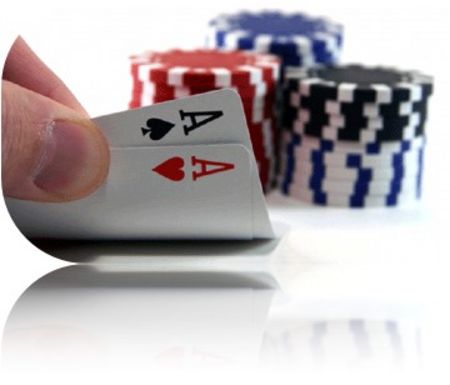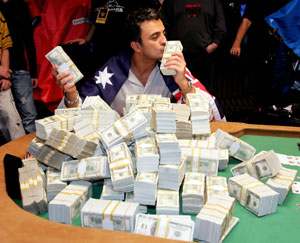Beginning/Intermediate Players
Early Position
Many players lose a lot of money playing too many hands in early position. There
are three distinct disadvantages when playing from early position;
-
Yon do not know how many players will be playing the hand,
- You are unsure of how much it will cost to play the hand since the pot could
be raised or even reraised behind yon.
- You will be acting before most of your opponents on every betting round.

For these reasons, you should play very few hands from early position.
Compare this to when you are sitting in late position where you have much more
information to make better decisions both preflop and after the flop. The same exact
hand can be profitable in late position yet lose money in early position.
For example, let's say you play K ♣ T ♣ in early position with a flop of K
♦ 9
♥ 5 ♠. The
big blind bets, so you raise with top pair. An opponent in middle position reraise and
then the big blind caps. You should fold losing two bets since you are probably
against a set, two pair, or a pair of kings| with a better kicker. If you were in late
position, you could have safely folded to the raise by the middle position player
without having committed money to the pot. You need strong hands from early
position to compensate for acting first on every betting round.
Unraised Pots
You should usually raise with the following premium hands: AA, KK, AKs, AK, AQs,
AQ, and AJs. Normally call with these hands: JJ, TT, 99, AJ, ATs, A9s, and KQs.
You can raise with JJ if the game is rather tight; otherwise, it is better to just call in
a loose game. If one player has already called, you can call also with 88, 77, A8s,
A7s, KJs, and QJs.
By the way in any position except for the blinds, once you have limped in, you
should almost always call a raise. If your hand was good enough to call in the first
place, it should be good enough to call one more bet with better pot odds. This
leads me into a good general rule for playing starling hands. Only call when a raise
behind you wouldn't be so bad.
For example, I would not be too happy having to call a raise with a small pair
against a lone opponent: however, this is not such a bad situation if there are
several callers. If you find yourself cringing a lot when an opponent raises, you are
probably playing too many hands.
If the pot is reraised and you are faced with two more bets, you should usually fold
unless you have a premium hand or your hand could play well in a multi-handed
pot. For example, you should fold hands like 99, ATs, and QJs for two more bets,
unless there are a lot of callers and you don't think the pot will be capped.
Raised Pots
If the pot has been raised, go ahead and reraise with AA, KK, QQ, AKs, and AK.
Usually just call with JJ, AQs, AQ, and AJs. Against some opponents whose raising
standards are not too strong, you might reraise with JJ or AQ. If you are against a
very tight player, you might fold AJs and possibly even AQ.
Middle Position

You can begin to play a few more hands in middle position than you would from
early position. On the other hand, some hands you might have played in early
position may now be unplayable if the pot has been raised. In middle position, you
have a little better idea of how many players will be in the pot, if the pot has been
raised, and the caliber of players who have entered the pot. All of this additional
information along with slightly better position allows you to play a few more hands.
Unraised Pots
Go ahead and raise with the same hands from early position. If you are the first one
to enter the pot, you should also raise with JJ, TT, AJ, ATs, and AT. You can also
add a few more hands to call with since there is now less of a chance that the pot
will be raised: 99, A9s, A8s, A7s, KQs, KQ, and KJs.
If there are already callers, you can call with a few more hands since you are
getting slightly better pot odds and your call may encourage others to call behind
you, With one caller add 88, 77, Axs, KTs, QJs, and QTs. With two callers add 66,
55, and JTs. With three callers add 44, 33, 22, J9s, T9s, and 98s.
Note mat trap hands should not be played from middle position: KJ, KT, and QT.
These hands rarely win large pots, unless you hit a straight, and can lose a lot of
money to hands with better kickers or players with good draws.
Raised Pots
If the pot has been raised, go ahead and reraise with AA, KK, QQ, AKs, and AK
and call with JJ, AQs, AQ, and AJs. If the raise is a lone raiser from middle position
and there are no other callers, you could reraise with all of those hands to try and
drive out the remaining players and isolate yourself against the raiser.
Late Position

You will make most of your money from Hold'em in late position as you are able to
act last on every betting round. You will know how many callers there are, who your
competition is, and whether or not the pot has been raised. All of this solid
information should allow you to make better and more profitable decisions.
Unraised Pots
One very important concept conies into play when you are in late position and
nobody has called yet. If you are going to play your hand, you should almost always
raise. Raising gives you a chance to steal the blinds or at least charge them a
higher price for playing. If they do call, you will have good position on every betting
round. In general, you can raise fist in with all of the following hands; any pair 77 or
higher, two cards jack or higher, two suited cards ten or higher, Axs, AT, and A9.
There are situations when you can raise other hands, but for most beginners it is
probably better to just play these hands.
With callers, raise with the same hands from early and middle position: AA, KK,
QQ, AKs, AK, AQs, AQ, and AJs. If there is only one caller, you can also raise with
JJ, TT, AJ, ATs, and KQs to try and isolate yourself against this lone opponent if
possible. If there are already two or more opponents in the hand, you should
normally just call with these hands.
You can play more hands with more callers:
One Caller: 99 88 77 AT Axs KQ KJs KJ KTs QJs QJ QTs JTs
Two Callers: 66 55 KT K9s QT Q9s J9s T9s
Three Callers: 44 33 22 K8s K7s JT T8s 98s
Four Callers: Kxs Q8s J8s 87s 76s
Raised Pots
When the pot has been raised and you are in late position, there are two important
considerations in dictating your strategy: position of the raiser and the number of
callers.
You should almost always reraise with AA, KK, QQ, AKs, and AK. If you are against
a lone opponent, you can either reraise or call with JJ, TT, AQs, AQ, and AJs
depending on their position and type of player, either reraise or fold with 99.
Generally you can call with KQs. although sometimes you can consider reraising a
late position raiser. AJ is not nearly as strong a hand as most people think.
Generally fold this to a raise unless you want to reraise a late position opponent.
If there is a raise and there are many callers, you can consider calling with other
hands. Small pairs and suited connectors 98s and higher play well in a multi-
handed pot. These hands generally need many opponents to give you good pot
odds on your speculative hand, so you shouldn't be calling raises very often. With
these hands you are hoping to hit a big hand on the flop; otherwise, you can safely
fold losing just two small bets. You can consider calling a raise cold against three
callers with 88 and 77. Against four callers add 66, 55, 44, 33, 22, QJs, and JTs.
Against five callers add T9s and 98s.
next...The Blinds

